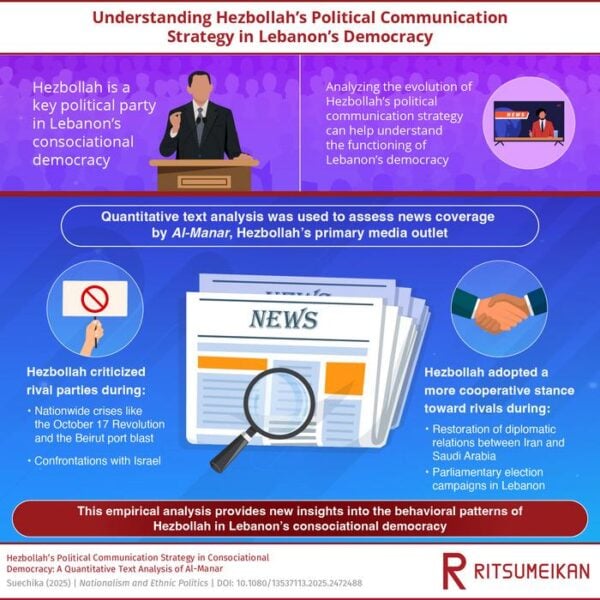A study using advanced text analysis has uncovered surprising patterns in how Hezbollah communicates with political rivals during Lebanon’s frequent crises. Rather than promoting unity during national emergencies, the powerful political-military organization actually intensifies criticism of opponents when Lebanon faces its greatest challenges.
This revelation comes from Japanese researcher Kota Suechika’s comprehensive analysis of seven years of news coverage from Al-Manar, Hezbollah’s official media outlet. The study, published last month in the journal Nationalism and Ethnic Politics, challenges conventional assumptions about political behavior during national emergencies.
“This study by employing quantitative text analysis methodologically contributes to an underdeveloped area of Arabic-language political discourse in Middle Eastern studies,” explains Suechika, a professor at Ritsumeikan University. “The findings of the study revealed that Hezbollah’s political communication is shaped by institutional constraints and strategic considerations within Lebanon’s consociational democracy, challenging the essentialist interpretations of Hezbollah’s conduct.”
Strategic Shifts: When and Why Hezbollah Changes Its Tone
The research examined over 64,000 news articles published between 2017 and 2023, a period marked by Lebanon’s deepening socio-economic and political crises. Using sophisticated data analysis techniques, Suechika tracked how Hezbollah’s messaging toward rival parties fluctuated during specific events.
Contrary to expectations that national crises would foster political unity, Hezbollah’s media coverage became notably more negative toward rival parties during two major emergencies: the October 2019 anti-government protests (known as the October 17 Revolution) and in the aftermath of the devastating 2020 Beirut port explosion.
Key Findings About Hezbollah’s Communication Strategy
- Hezbollah grew more critical of rival parties during national crises, trying to shift blame rather than promote cooperation
- When discussing Israel, Al-Manar’s coverage showed stronger tendencies to associate rival Lebanese parties with negative terms like “sectarianism” and “division”
- Hezbollah adopted a notably friendlier tone toward rivals after the 2023 Iran-Saudi diplomatic reconciliation
- Coverage became more positive toward other parties during parliamentary election campaigns, when cross-sectarian alliances were crucial
- Messaging grew more hostile during post-election cabinet formation periods
The data indicates Hezbollah strategically adjusts its political communication to maximize organizational survival and influence, rather than adhering to rigid ideological positions. This flexibility challenges simplistic interpretations of the organization as merely driven by religious or sectarian motives.
Beyond Cultural Essentialism
The study directly challenges what Suechika describes as “the static perspective on Hezbollah’s behaviors, characterized by the dual concepts of Islamism and sectarianism,” which he argues “remains entrenched in the notions of cultural essentialism and classical Orientalism, which seeks to explain it by cultural factors such as religion and sect.”
Instead, the evidence suggests a pragmatic political actor navigating Lebanon’s complex landscape of sectarian power-sharing. The organization’s communication strategy responds to both domestic institutions and regional dynamics.
The Iran-Saudi Connection
Perhaps most revealing was the dramatic shift in tone following the China-brokered reconciliation between Iran and Saudi Arabia in March 2023. Hezbollah’s messaging toward rival parties became significantly more positive after this diplomatic breakthrough.
This finding confirms the strong influence of regional politics on Lebanon’s internal dynamics, particularly the proxy competition between Iran and Saudi Arabia that has long played out in Lebanese politics.
At the time, Secretary-General Nasrallah referred to the reconciliation between Iran and Saudi Arabia as “a positive development that could potentially open new horizons across the region” and expressed hope their deal would have “positive repercussions on the Lebanese presidential election.”
What does this suggest about Lebanon’s ongoing political deadlock? The study indicates the problem may run deeper than any single party’s behavior.
“This suggests that Lebanon’s socio-economic and political crises stemmed not from Hezbollah’s uncompromising political stance but from the inherent failures of the consociational democracy itself, which fosters unaccountable elite rule of Lebanon’s long lasting sectarian oligarchy,” Suechika concludes.
As Lebanon continues navigating multiple crises, this research provides valuable insight into how one of its most powerful political actors calculates its messaging. The question remains whether other Lebanese parties follow similar patterns – something Suechika suggests as a direction for future research that could reveal broader dynamics in how Lebanon’s sectarian political system functions under pressure.
If our reporting has informed or inspired you, please consider making a donation. Every contribution, no matter the size, empowers us to continue delivering accurate, engaging, and trustworthy science and medical news. Independent journalism requires time, effort, and resources—your support ensures we can keep uncovering the stories that matter most to you.
Join us in making knowledge accessible and impactful. Thank you for standing with us!

